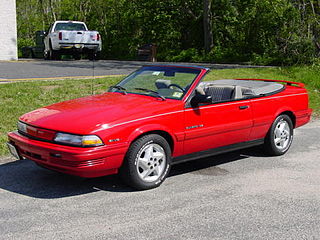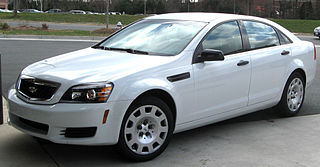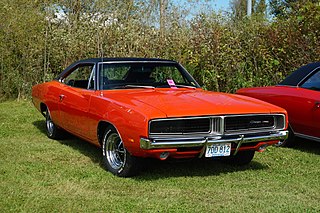
The Ford Thunderbird is a personal luxury car manufactured and marketed by Ford from model years 1955 to 2005, across 11 generations. Introduced as a two-seat convertible, the Thunderbird was offered variously as a four-seat hardtop coupe, four-seat convertible, five-seat convertible and hardtop, four-door pillared hardtop sedan, six-passenger hardtop coupe, and five-passenger pillared coupe, with the final generation designed again as a two-seat convertible.

The Pontiac Sunbird is a model line that was manufactured and marketed by Pontiac from the 1976 to the 1994 model years. Loosely deriving its name from the Pontiac Firebird, the Sunbird was introduced as the eventual replacement for the Pontiac Astre, replacing it entirely in 1978 as the smallest Pontiac.

The Chevrolet Caprice is a full-size car produced by Chevrolet in North America for the 1965 to 1996 model years. Full-size Chevrolet sales peaked in 1965 with over a million sold. It was the most popular car in the U.S. in the 1960s and early 1970s, which, during its lifetime, included the Biscayne, Bel Air, and Impala.

Mercury Cougar is a nameplate applied to a diverse series of automobiles sold by the Mercury division of Ford from 1967 until 1997 and from 1999 through 2002 model years. While the nameplate is associated with two-door coupes, at various times during its production, the Cougar was also marketed as a convertible, four-door sedan, station wagon, and a hatchback.

The Dodge Charger is a model of automobile marketed by Dodge in various forms over seven generations since 1966.

The Cadillac CTS is a luxury car, manufactured and marketed by General Motors from 2003 until 2019 across three generations.

The Lincoln LS is a four-door, five-passenger luxury sedan manufactured and marketed by Ford's Lincoln division over a single generation from 1999–2006. Introduced in June 1999 for model-year 2000, the LS featured rear-wheel drive and near 50/50 weight distribution and was available with a V8 or V6, the latter initially offered with a manual transmission. The LS aimed to provide a blend of luxury and sport to attract a new generation of buyers to the Lincoln brand.

The LincolnMark VIII is a grand touring luxury sport coupe that was marketed by Lincoln from the 1993 to 1998 model years. The first generation of the Mark series branded entirely as a Lincoln, the Mark VIII again served as a counterpart of the Ford Thunderbird and Mercury Cougar. Though maintaining its traditional brand rivalry with the Cadillac Eldorado, the Mark VIII was also developed to become more competitive against luxury coupes from automakers around the world.

The Essex V6 is a 90° V6 engine family built by the Ford Motor Company at the Essex Engine Plant in Windsor, Ontario, Canada. This engine is unrelated to Ford's British Essex V6. Introduced in 1982, versions of the Essex V6 engine family were used in subcompact through to large cars, vans, minivans, and some pickup trucks. The Essex V6 was last used in the 2008 regular-cab F-150, after which it was succeeded by a version of the Ford Cyclone engine. An industrial version of the engine was available until 2015.

The Shelby Mustang is a high-performance variant of the Ford Mustang built by Shelby American from 1965 to 1967 and by the Ford Motor Company from 1968 to 1970.

The Chevrolet Monte Carlo is a two-door coupe that was manufactured and marketed by the Chevrolet division of General Motors. Deriving its name from the city in Monaco, the Monte Carlo was marketed as the first personal luxury car of the Chevrolet brand. Introduced for the 1970 model year, the model line was produced across six generations through the 2007 model year, with a hiatus from 1989 to 1994. The Monte Carlo was a closely aligned variant of the Pontiac Grand Prix through its entire production.

The Ford MN12 platform is a car platform that was used by the Ford Motor Company from 1988 to 1997 for the 1989–1997 model year Ford Thunderbird and Mercury Cougar two-door personal luxury cars. A variant of this platform, known as the FN10, was used for the 1993–1998 model year Lincoln Mark VIII from 1992 to 1998. Each car based on this platform had a front-engine, rear-wheel drive layout with an independent rear suspension.

The Infiniti G Line is a series of compact executive cars produced by Infiniti, a luxury division of Nissan, for the 1991–1996 and 1999–2016 model years. The first two generations of the Infiniti G were sedans based on the Nissan Primera. Beginning with its third generation (V35), the Infiniti G have been rebadged versions of the Nissan Skyline line of sedans and coupes that were exported to the United States and Canada. The final incarnation is the fourth generation (V36) which introduced the hardtop coupe convertible. The Nissan FM platform, on top of which the third and fourth generations of the Infiniti G have been built, also underpins the Nissan 370Z and has shared components with the Infiniti M, Infiniti EX, and Infiniti FX.

The third-generation Chevrolet Camaro is an American pony car which was introduced for the 1982 model year by Chevrolet. It continued to use General Motors' F-body platform and produced a "20th Anniversary Commemorative Edition" for 1987 and "25th Anniversary Heritage Edition" for 1992. These were also the first Camaros with factory fuel injection, four-speed automatic transmissions, five-speed manual transmissions, four-cylinder engines, 16-inch wheels, and hatchback bodies. For 1987 a convertible Camaro was reintroduced, converted by ASC in relatively small numbers. The third-generation Camaro continued through the 1992 model year.

The third-generation Mustang was produced by Ford from 1979 until 1993. Built on Ford's Fox platform, it is commonly referred to as the Fox body Mustang. It evolved through several sub-models, trim levels, and drivetrain combinations during its production life. It underwent updates for the 1987 model year and seemed destined for replacement with a front-wheel drive Mazda platform. However, company executives were swayed by consumer opinion and the rear-wheel drive Mustang stayed, while the front-wheel drive version was renamed the Ford Probe. Enthusiasts group the generation into two segments: the 1979–1986 cars, with their quad headlight arrangement, and the 1987–1993 cars, with their aerodynamic composite headlamps and front fascia styling. Production ended with the introduction of the fourth-generation Mustang (SN-95) for the 1994 model year.

The fourth-generation Ford Mustang is an automobile that was produced by the American automobile manufacturer Ford for the 1994 through 2004 model years. Marking the first major redesign of the Ford Mustang in fifteen years, the fourth generation of the pony car was introduced in November 1993 with the launch taking place on December 9, 1993. The design, was based on an updated version of the Fox platform and was the final vehicle underpinned with this platform. It featured styling by Bud Magaldi that incorporated some stylistic elements from the classic Mustangs. A convertible model returned, but the previous notchback and hatchback bodystyles were discontinued in favor of a conventional 2-door coupe design.

The fifth-generation Ford Mustang (S197) is a pony car that was manufactured by American automobile manufacturer Ford from 2004 until 2014, at the Flat Rock Assembly Plant in Flat Rock, Michigan. The fifth generation began with the 2005 model year, and received a facelift for the 2010 model year. Originally designed by Sid Ramnarace through late 2001 and finalized in mid-2002, the fifth-generation Mustang's design was previewed by two pre production concept cars that debuted at the 2003 North American International Auto Show. Development on the S-197 program began in 1999 under chief engineer Hau Thai-Tang, shortly after the 1998 launch of "New Edge" SN-95 facelift. From the second half of 1999, design work commenced under Ford design chief J Mays, and concluded in July 2002 with the design freeze. There have been several variants of the fifth-generation Ford Mustang that include the Mustang GT/California Special, Shelby Mustang, Bullitt Mustang, and Boss 302 Mustang.

The eighth generation of the Ford Thunderbird is a personal luxury coupe that was manufactured and marketed by Ford from the 1980 to 1982 model years. Introduced to commemorate the 25th year of the Thunderbird, the eighth generation was substantially downsized, transitioning further into the mid-size segment. For a second generation, the Thunderbird remained the Ford counterpart of the Mercury Cougar XR7; while the Cougar again served as a complete line of mid-sized cars in various body styles starting with 1981 models, the Thunderbird was offered solely as a two-door personal luxury coupe.

The ninth generation of the Ford Thunderbird is a personal luxury coupe that was manufactured and marketed by Ford for the 1983 to 1988 model years. In response to the sales downturn of the 1980–1982 Thunderbird, the Thunderbird underwent an extensive model revision for the 1983 model year. While remaining a personal luxury coupe, the redesign of the Thunderbird marked a transition of the model range, emphasizing performance and handling over outright luxury and comfort content. As a central theme of the design, the ninth-generation Thunderbird marks the introduction of highly aerodynamic body design to Ford vehicles in North America, followed by similarly designed model lines, including the 1984 Ford Mustang SVO, 1984 Ford Tempo, 1986 Ford Aerostar, and 1986 Ford Taurus.

The sixth-generation Chevrolet Camaro is an American pony car. Produced by automobile manufacturer Chevrolet, it was first introduced to the public on May 16, 2015. Sales started in 2015 for the 2016 model year. The Camaro now utilizes the GM Alpha platform shared with the Cadillac ATS and CTS and features MacPherson struts in front, rather than the former multi-link setup. General Motors claims that 70 percent of architectural components in the new Camaro are unique to the car.























